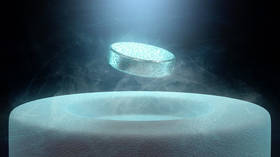The future is now? Scientists achieve superconductivity at room temperature in potentially revolutionary breakthrough

Physicists have reached a major milestone, achieving superconductivity at room temperature, bringing humanity one major step closer towards several revolutionary technologies which would change life as we know it.
Superconductivity is a phenomenon in which an electrical charge moves through a material without resistance, in other words, with perfect efficiency.
The previous record for superconductivity was achieved at -23 degrees Celsius, but now researchers at the University of Rochester have managed the same feat at a relatively tropical 15 degrees Celsius (59 degrees Fahrenheit).
This marks one major step towards functional superconductivity which would change a vast array of everyday technologies, from electricity grids to computers and electronic devices to intercontinental mass transit.
“Our discovery will break down these barriers and open the door to many potential applications,” physicist Ranga Dias of the University of Rochester said in a press statement.
Up until this point in history, superconducting has largely been confined to laboratory settings, in extremely cold micro environments typically far below those found in nature, due to the materials used.
However, recent advances in materials science have afforded physicists the opportunity to create superconductive materials that function at room temperature.
There is one large, or incredibly small, caveat, depending on your perspective: for now, at least, the superconductor breakthrough has only been achieved using a carbonaceous sulphur hydride (combination of carbon, sulphur and hydrogen, crushed using a diamond anvil at 270 gigapascals or two million times standard atmospheric pressure).
As a result, the superconductive materials only measure between 25 and 35 microns (0.025mm).
Also on rt.com ‘Clean, limitless’ power, generated by ‘miracle material’ graphene in major breakthrough, but there’s a catchTherefore, there is still a long way to go before superconductivity can be achieved at normal pressures at room temperature where it could realistically be brought to bear in our technology, but the latest breakthrough takes humanity one step closer ambient-pressure superconductivity and the plethora of technological revolutions that would entail.
While it all sounds a bit science fiction, the applications of functional superconductivity would be truly revolutionary: maglev (magnetic levitation) trains, which can travel at speeds that rival high-speed rail and airplanes, would likely become more widespread on a global scale, reducing pollution from air travel; power grids would be far more efficient, reducing energy waste across the world; data transfer could reach previously unfathomable speeds, allowing for unprecedented informational and data exchange hitherto unseen in mankind’s history.
Think your friends would be interested? Share this story!












